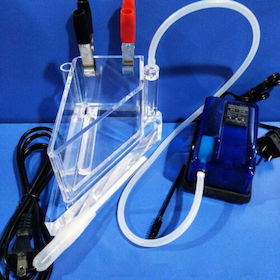
-----
No chrome plating in low current density area
Q. We chrome plate T-brackets for bathrooms. We are not getting any chrome coverage in the low current density areas - the corners of the "T". We are getting excellent nickel coverage. Could the nickel be too passive in those areas? Any assistance with this matter would be greatly appreciated.
Matthew S. Maurer, Senior Chemistplating company - Ashtabula, Ohio, United States
2000
|
A. It depends on the type of chromium solution that you are using. A good well balanced solution will cover the T. Unfortunately these type of solutions are proprietary solutions so they cost more. Anyhow it is not a matter of passive nickel as passive nickel will mainly cause white wash stains.  Sara Michaeli Tel-Aviv-Yafo, Israel A. Matthew, First, slowly raise the current and let the part be warm the same temperature as the chrome solution have. Second, try to copy the part and build a help anode. This is to get the current easier to the T-bracket. Start with a activation in chrome solution beneath the chrome's depositions 0,52 voltage for 3 minutes. You can also try to give kick with the current over plating Amps. Have you analyses chrome solution about the ratio Cr-sulphate maybe this is to low. Did you have to high temperature in the solution. How long time between the Ni and Cr. Good Luck to you  Anders Sundman 4th Generation Surface Engineering Consultant - Arvika, Sweden |
A. Passive nickel will reduce chrome coverage. Carbon treatment of the nickel will extend chrome coverage.
You can test this using a dupli-cell and a Hull Cell
⇦ huh?
.
Plate a panel with your nickel in a square cell.
Then rinse the panel with water, and plate with your chrome in the Hull Cell. Measure the coverage with a ruler.
Now carbon treat the nickel solution and run the test again.
You will see the chrome coverage increase.
But before that, run Hull Cell panels and see if you get 70% coverage in a 267ml Hull Cell panel. If you get 40 or 50% coverage, you need to get that chemistry right first.

Tom Pullizzi
Falls Township, Pennsylvania
A. I agree with Tom Pullizzi. It could be your bright nickel is running hot. Too much brightener can affect your chromium process.It may lead to reduced throw & a tendency for burning.
Peter Wilson- Ontario, Canada
A. Matthew, All is correct, I would like to also suggest that you look at contaminate level of your chrome solution ... with the efficiency of chrome being so low, that throwing power is lost by small increases of contaminates such as chloride, iron, copper, trivalent. This will show up in the LCD areas first. The best way I have found to to correct this problem is to use a porous pot on a regular set intervals
Chris Snyderplater - Charlotte, North Carolina
Q, A, or Comment on THIS thread -or- Start a NEW Thread
